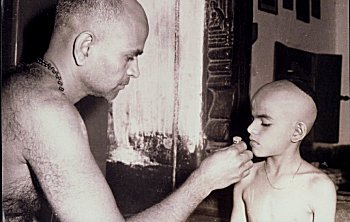The Upanayana Samskar
by Dr. Jyotsna Kamat
First Online: December 01, 2006
Page Last Updated: December 07, 2024
The Upanayana (a.k.a. Munji or initiation) samskar (refinement in Hinduism) was meant to initiate a boy into education and learning. Upa meant near and nayana meant taking. Taking the child for education to guru (teacher) was an important step. The Gurukulas were residential schools in ancient times. After the Upanayana ceremony, the understudy was to reside with his guru and learn different arts and crafts besides Vedic lore. Usually Upanayana was performed in the eighth year. It could be extended to sixteen years among brahmins and twenty four years for other castes.
Girls in the vedic age also had initiation; slowly the practice faded out due to several cultural setbacks.
This discipline of upanayana or initiation is compared by some to the Baptism of Christians. ("Except a man be born again, he cannot see the kingdom of God", St. John). This samskar turned a boy into twice-born (Dvija) as by birth. All persons were born Shudras according to a learned sage Atri. Discipline made him Dvija (twice born or a brahmin).
Various rites were connected with Upanayana.
- Last feeding by the mother (Matribhojan)
- Choula (tonsure and bath)
- Wearing loin-cloth and Mounji girdle (Kaupina)
- Putting on yajnopavita (scared thread)
- Carrying danda (staff).
- Initiation by Guru through recitation of the Gayatri mantra
- Seeking of alms by the boy (Bhiksha)
- Adopting sandhyavandan prayer for life.
Mantras to purify the Vatu were recited by the priest throughout. Role of relatives, father, mother, uncle, sister, brother etc. in different rites is specified. The sacred fire was brought to the place by the mother of the boy herself and lit ready for homa. Agni or the Fire-God was a link between humans and Gods.
K.L. Kamat/Kamat's Potpourri
Introduction to the Mudras
Proceedings of a Upanayanam ceremony for a boy
The attire prescribed for the boy to be initiated had special significance and needs different elaboration. Yajnopavita is the most important. Of specific length (ninety six times the breadth of the four fingers of a man which is equal to his height. Each finger is supposed to represent four states of consciousness of the soul. Waking (jagrat) dreaming, (svapna) deep sleep (sushupti) and transcendental consciousness (turiya). Three folds of the sacred thread represent three Gunas (satva, raja and tama). The three strands were tied together by a knot called Brahmagranthi which symbolized Brahma, Vishnu and Shiva.
Mantras of Upanayanam Ceremony
The priest, representing the Guru prayed the deities including Savit -- Sun god. Then the sacred Gayatri mantra is taught to the boy (Vatu).
"Let us meditate on the excellent Light of the Divine Impeller i.e., Savitar. May the Divine light inspire our intellect "
Invocation of the supreme intelligence is specific to Hindu ethos.
In early centuries, the Upanayana ceremony was observed for three days. On the fourth day a rite called Medhajanana (Generation of intelligence) was performed. The mantra runs like this:
May the all-pervading Goddess of Intellect, beneficial, favorably disposed to and delighting in us grace us by Her Presence! O Goddess! We were delighting in useless speech before. May thy visit enlightened and capable of expressing the Supreme Truth fearlessly !
Learning to recite the Gayatri Mantra was the high point of Upanayana. Once the Vatu was taught recitation of gayatri mantra methodically, he was expected to do Sandhya Vandan thrice a day. This prayer to Sungod was offered at dawn, noon and dusk (sandhya refers to twilight, morning or evening. Noon is known as 'Sandhi'. Hence Sandhyavandan referred to all three timings). Ritual sprinkling of water and recitation of Gayatri mantra one hundred and eight times were prescribed. Gayatri means that which protects (trayate) the reciter (gayan).
Decline of the Upanayana Samskara
As an educational samskar, Upanayana was universal. With receding of the Gurukul system, Upanayana ceremony lost its original importance. It has remained only a ritual and as a caste mark for the so called higher-castes. Upanayana custom once prevailed among Shudras or servant class as well. Only difference was non-existence of Gayatri and other mantras.
These days the Upanayana ceremony has come to stay only as a show of vulgar wealth, socializing and feasting. Many go without initiation. Just before marriage three stringed sacred thread is worn, to make up the loss! After this hasty ritual only a person gets qualified to become a bride-groom!
![]()
See Also:
- Boy Becomes Man -- Pictorial exhibition of the Hindu ordaining ritual known as the Upanayanam or Munji

